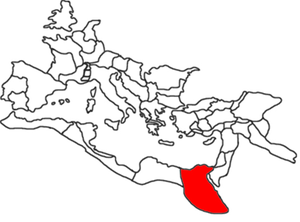Aegyptus Province
|
|
Aegyptus was, in ancient geography, a province of the Roman Empire, encompassing most of modern-day Egypt except for the Sinai Peninsula. Aegyptus was bordered on the west by the province of Cyrenaica and on the east by the province of Arabia.
The area originally came under Roman rule in 30BC, and served as a major producer of grain for the empire.
Roman conquest of Egypt
In 30 BC, following the death of Cleopatra, Egypt became part of the Roman Empire as the imperial province of Aegyptus, governed by a prefect selected by the Emperor from the Equestrian and not a governor from the Senatorial order, to prevent interference by the Roman Senate.
The main Roman interest in Egypt was always the reliable delivery of grain to the city of Rome. To this end the Roman administration made no change to the Ptolemaic system of government, although Romans replaced Greeks in the highest offices. But Greeks continued to staff most of the administrative offices and Greek remained the language of government except at the highest levels. Unlike the Greeks, the Romans did not settle in Egypt in large numbers. Culture, education and civic life largely remained Greek throughout the Roman period. The Romans, like the Ptolemies, respected and protected Egyptian religion and customs, although the cult of the Roman state and of the Emperor was gradually introduced.
Roman rule in Egypt
The first prefect of Aegyptus, Gaius Cornelius Gallus, brought Upper Egypt under Roman control by force of arms, established a protectorate over the southern frontier district, which had been abandoned by the later Ptolemies. The second prefect, Aelius Gallus, made an unsuccessful expedition to conquer Arabia Petraea: the Red Sea coast of Egypt was not brought under Roman control until the reign of Claudius. The third prefect, Gaius Petronius, cleared the neglected canals for irrigation, stimulating a revival of agriculture.
As-Hadrian-Aegyptus-RIC_0839,As.jpg
From the reign of Nero onwards, Aegyptus enjoyed an era of prosperity which lasted a century. Much trouble was caused by religious conflicts between the Greeks and the Jews, particularly in Alexandria, which after the destruction of Jerusalem in AD 70 become the world centre of Jewish religion and culture. Under Trajan a Jewish revolt occurred, resulting in the suppression of the Jews of Alexandria and the loss of all their privileges, although they soon returned. Hadrian, who twice visited Aegyptus, founded Antinoöpolis in memory of his drowned lover Antinous. From his reign onwards buildings in the Greco-Roman style were erected throughout the country.
Under Marcus Aurelius, however, oppressive taxation led to a revolt (139) of the native Egyptians, which was suppressed only after several years of fighting. This Bucolic War caused great damage to the economy and marked the beginning of Aegyptus's economic decline. Avidius Cassius, who led the Roman forces in the war, declared himself Emperor, and was acknowledged by the armies of Syria and Aegyptus. On the approach of Marcus Aurelius, however, he was deposed and killed, and the clemency of the emperor restored peace. A similar revolt broke out in 193, when Pescennius Niger was proclaimed emperor on the death of Pertinax. The Emperor Septimius Severus gave a constitution to Alexandria and the provincial capitals in 202.
The most revolutionary event in the history of Aegyptus was the introduction of Christianity in the 2nd century. It was at first vigorously persecuted by the Roman authorities, who feared religious discord more than anything else in a country where religion had always been paramount. But it soon gained adherents among the Jews of Alexandria. From them it rapidly passed to the Greeks, and then to the native Egyptians, who found its promise of personal salvation and its teachings of social equality appealing. The ancient religion of Egypt put up surprisingly little resistance to the spread of Christianity. Possibly its long history of collaboration with the Greek and Roman rulers of Egypt had robbed it of its authority.
Caracalla (211-217) granted Roman citizenship to all Egyptians, in common with the other provincials, but this was mainly to extort more taxes, which grew increasingly onerous as the needs of the Emperors for more revenue grew more desperate. There was a series of revolts, both military and civilian, through the 3rd century.
Under Decius, in 250, the Christians again suffered from persecution, but their religion continued to spread. In 272 Zenobia, queen of Palmyra, briefly conquered Aegyptus, but lost it when Aurelian crushed her rebellion against Rome.
Two generals based in Egypt, Probus and Domitius Domitianus, led successful revolts and made themselves Emperor. Diocletian captured Alexandria from Domitius in 296 and reorganised the whole province. His edict of 303 against the Christians began a new era of persecution. But this was the last serious attempt to stem the steady growth of Christianity in Egypt.
See also: History of Greek and Roman Egypt
Template:Roman provinces 120 ADde:Aegyptus fr:Égypte (province romaine) nl:Alexandria et Aegyptus

